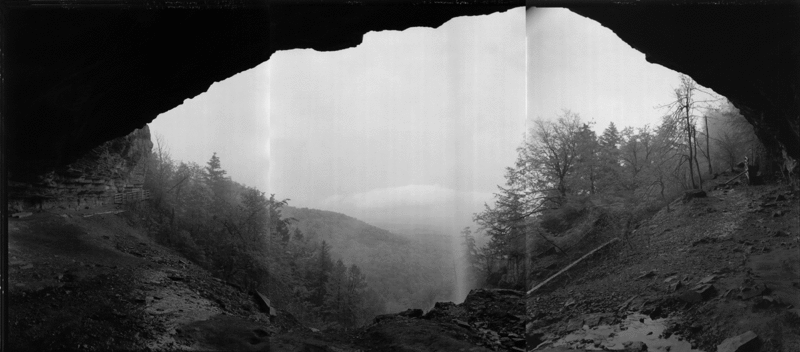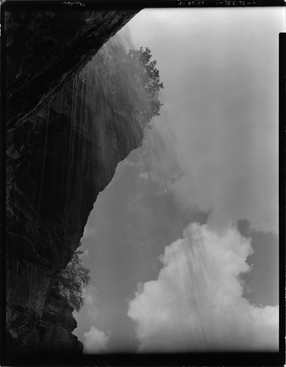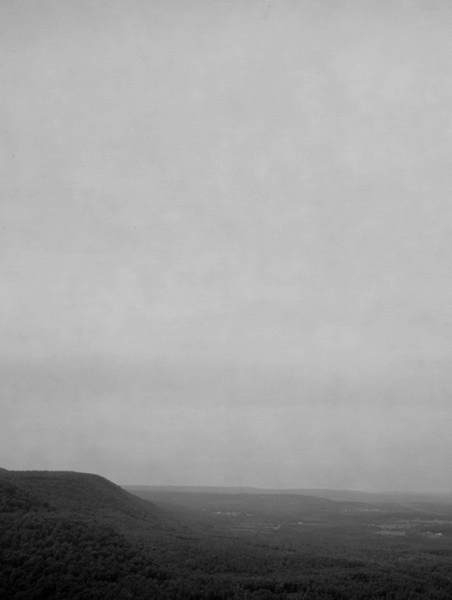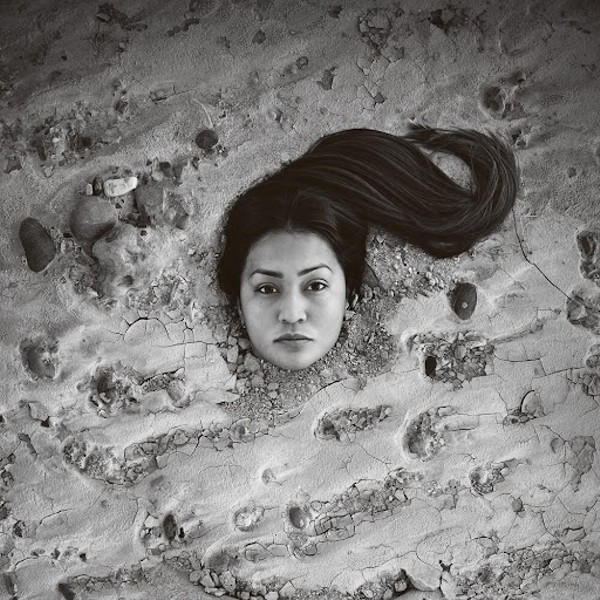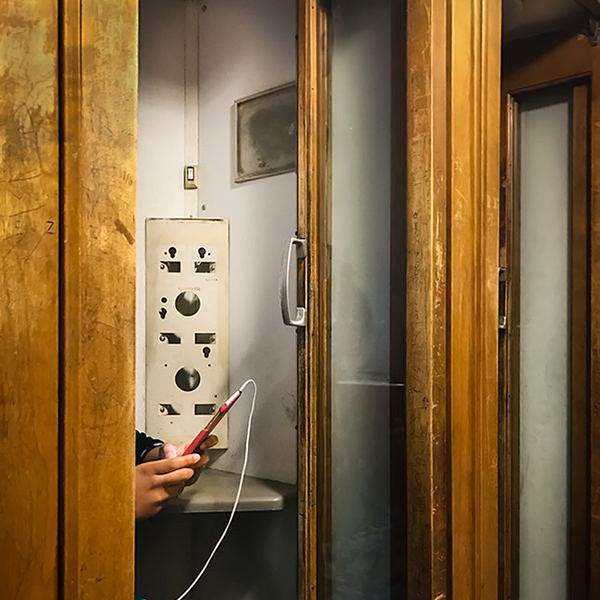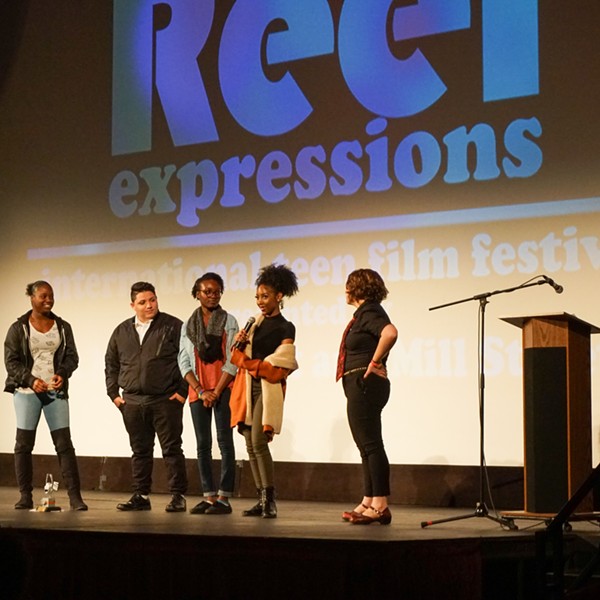Looking at John Yang’s pictures of Thacher Park is like going back in time—geologic time. Many of the New York City-based photographer’s images of the Indian Ladder Trail (a long-popular attraction in the family-friendly state park west of Albany) are such close-cropped details of the rock—striated, layered, chipped, and chunked as it is—that you couldn’t imagine where or when these pictures were taken. And the landscape views, though quite classic in their way, are rendered in such subtle, misty tones, that they, too, seem to be of another age and a distant geography.
This displaced quality is both the magic and the necessity of Yang’s photography, now hanging in a solo exhibition at the Albany Institute of History & Art. Without it, we’d just be looking at the thing he photographed. With it, we are transported.
Yang spent five years making and sequencing the 38 prints that comprise “Indian Ladder, A Lyric Journey,” which is a long time—since it took Mother Nature many millions of years to create his subject matter, it seems fitting that he would approach it slowly. Yang grew up in New York, and brings a distinct East-West sensibility to this work. In an 80-page, full-color catalog that accompanies the exhibition, he says: “I am, by upbringing, a Confucian. I am, by nature, a Taoist. I am, by outlook, a Puritan.” This amalgamation of devotion to family, cultivation of simplicity, selflessness, and strict morality seems to have served Yang well in pursuing his arduous and reflective photographic method.
Born in China in 1933, he began showing his pictures in New York galleries and museums in the 1960s; he worked for more than 20 years as an architect before retiring in 1978 and devoting himself fully to his art. Yang shares significant characteristics with a number of other Asian or Asian-American photographers: They work slowly, with large cameras; they make low-key prints, often emphasizing a very narrow tonal range within the black-and-white continuum; and they distill quiet images from simplified subjects—usually still life, the nude, or landscape. Examples of this type of subtle work are readily available from Japanese-born photographers (Hiroshi Sugimoto and Kenro Izu come to mind); Yang is among a group of lesser-known Chinese-American photographers working in this mode.
Visually, Yang’s work harks back to photographers of the American West—not Ansel Adams, or Minor White (with whom he studied) so much as the 19th-century greats William Henry Jackson, Timothy O’Sullivan, and Carleton Watkins. But, whereas they created their monumental works depicting subjects such as Yosemite and Yellowstone, Yang has almost arbitrarily chosen the Helderberg Escarpment (“It’s something I stumbled upon,” he says), made it his own, and given it back to us transformed.
Yang’s technique, as in all photography, is important in its specifics. The prints are all black and white, but Yang’s use of gold toner gives them a surprisingly broad range of colors. Some read as the neutral gray of an everyday gelatin-silver print, but the rest range from a deep eggplant to a rusty, almost orange hue. Within the individual prints, an overall warmth pervades (think of sepia), especially in the highlights. He uses a cobbed-together, 11-by-14-inch view camera—the kind you have to put a big, dark cloth over your head to look through— and contact-prints the oversized negatives on English printing-out paper: slow, purplish sheets that develop in sunlight and, through toning, render various degrees of opalescence. At the Albany Institute, the camera and Yang’s darkroom setup are the first things you see before passing through a door into the gallery that holds the Thacher Park pictures.
(This is both an advantage and a shame. Though Yang built the camera himself from spare parts, and though his printing process is archaic and laborious—and therefore fascinating—it is still the pictures that matter most, not the process of making them. Too many people think photography as an art form is somehow about the equipment; I would hate for the Institute to unwittingly further this impression by placing a crazy-looking camera and an old-fashioned darkroom at the entry of such a highly sophisticated exhibition.)
There is a diverse range of subjects and perspectives to the images. They can be categorized variously into different groups: grand views and intimate views; above the ledge and below the ledge; rocks; trees; water, ice and snow; looking up or down; and so on. Unique in the collection is a panoramic triptych made of three vertical views joined together, that looks out from beneath a wide overhang, past a narrow cascade, and into the distance of the valley beyond. At about 14 by 33 inches it is large for a silver print, and it has stronger shapes and contrasts than most of Yang’s other pictures, which tend to favor atmosphere over composition.
The heart of the group, nine prints that focus on the cliff walls exclusive of other content, is a reverent homage to the elements. “I love rocks,” Yang says, “and when photographing the cliffs along Indian Ladder Trail I tried to capture the rhythmic play between the wave-like striations and the abrupt vertical fractures of the Coeymans and Manlius limestone beds.” Yang does far more than capture that rhythm—like a classical composer, he gives it an orchestral voice. The cathedral-like spaces he has recorded nearly make religion out of geology.
Many of the prints are presented as ovals, an affectation I initially found difficult to accept, but then was surprised at how convincing the images became. When asked why he picked up this habit, Yang extols the freedom of creating within a non-rectilinear space—where you can’t “get stuck in a corner.” “It’s conducive to a certain flowing kind of subject,” he says of the oval, where the content “becomes more of a perceptual whole.”
Yang previsualizes these pictures by means of an elliptical guide on the camera’s ground glass, so that the final vignetted scene is true to what he saw when he shot it. This method speaks to his commitment to maintaining the integrity of the original negative when he prints, an ethos that stands in opposition to the classic manipulations of cropping, enlarging, etc., not to mention today’s nearly ubiquitous digital intrusions.
One can’t help but wonder, since it seems as if Yang has successfully ignored life in the 21st century, how this work can be relevant today. What is the point of making pictures in such a labor-intensive manner in a time when you can reproduce just about any effect (quite beautifully, too) using digital methods of capture or output? Is the popularity of his style (work of this sort sells well in big-city galleries, and the Institute has acquired a number of Yang’s prints for its permanent collection) mainly fueled by nostalgia?
While I suspect a certain amount of wishful escapism, back to “a simpler time,” brings some people to appreciate artwork like John Yang’s, that sentiment would be far from his motives for making it. At the outset, there is the direct, personal response to a subject. The first time Yang went to Thacher Park, in 1987, he found it compelling but was dissatisfied with the pictures he made there. However, he says, “it stayed in my mind.” Then, as he puts it, “the project took over.”
This is the way it is with all artists—they find a subject, or process, and then immerse themselves in it. Each has his or her own method; in Yang’s case, the contemplative shooting approach and the alchemical printing process suited the way he saw his subject. Unlike his photographic predecessors, whose agendas ranged from 19th-century Manifest Destiny to 20th-century Modernism, Yang is postmodern in his singular devotion to following his instincts without regard to a movement or ideology.
In staying true to himself, he has crafted a highly personal and affecting body of work from an ancient, relatively unknown geological formation many miles from his home. He has done it with persistence, extreme physical effort, and deep reflection. Yang’s “lyric journey”—subtle, mysterious, even elusive—is well worth taking.
YANG TO YANG
Excerpt from “A Talk with John Yang,” an artist’s statement by John Yang in which the photographer interviews himself. The full interview is in the catalog Indian Ladder, A Lyric Journey: Photographs by John Yang, published by the Albany Institute of History and Art.
Q. Tell me a little bit about yourself.
A. I am, by upbringing, a Confucian. I am, by nature, a Taoist. I am, by outlook, a Puritan. I’ll leave it at that.
Q. Are there contemporary photographers or artists you admire?
A. I don’t know how contemporary they are, but I very much admire the early work of Robert Frank—Lee Friedlander, too. I can’t really comment on the current photographic scene because I haven’t kept up.
I very much admire the books of Ed Ruscha. Folk art, too, appeals to me. I also like Edward Hopper. Critics say a few nice things about him, only to go on to dismiss his work. John Adams, the writer and photographer, said—and I agree—that he has a photographer’s eye. In his paintings I hear an unearthly silence.
Q. Am I correct in noting that there is also an unearthly silence that can be heard in many of your photographs?
A. Could be. Someone once said that my pictures have a distinctive elegiac tone, that they are pictures taken in a minor key.
Q. Is it true, as a critic once observed, you work on one project at a time, and each project takes about five years to complete?
A. That’s about right. There is one project that I’ve been working on continually for more than three decades, mostly during winters. I’ve been photographing the woods, or “tangles” of various public parks in the outer boroughs of New York City, as well as the many overgrown preserves and sanctuaries—“pockets of wilderness”—in the metropolitan area. My photographs of these woods, except for one, do not resemble any of those taken at Thacher. Nor do they resemble the work of any of my previous projects.
Q. How did you discover Thacher Park and the Indian Ladder Trail?
A. Through a geology field guide of upstate New York by Bradford B. Van Diver, a professor of geology at the State University of New York, Potsdam, which I bought sometime in the 1980s. There was a reference to Thacher Park and the trail, along with a photograph of Minelot Falls. Van Diver noted there were cliffs 100 feet high. I couldn’t believe such a place existed in the east, only 170 miles from New York City, where I live. I first went to take pictures in November of 1987. None of the pictures were any good. I went back in the fall of 2001 with my 11” x 14” view camera to photograph the cliffs, not realizing then, because of the severe drought that year, that two waterfalls usually flowed over the ledge.
I went back in the spring of 2003 and continued to photograph at Thacher through the fall of 2006, and then once again in early 2007. Most of my photographs were taken in early spring or late fall. Photographing the cliffs in the summer is difficult because of the heavy underbrush. The trail is closed in the winter because of ice and snow.
Q. All your photographs of the cliffs appear to have been taken in the shade. Is that by choice or circumstance?
A. Both. By circumstance, because the orientation of the Helderberg Escarpment generally faces northeast, so that the only time the cliffs receive direct sun is in the morning in mid-summer. By choice, because shadows can make or break a picture, and for what I wanted to do they usually just got in the way.
Q. Has anyone ever told you that they prefer seeing your pictures of a place to the place itself?
A. Yes they have, but I don’t put too much stock in it. I would rather be told that my pictures reveal something about the place that they hadn’t seen before.
Q. Why did you use a large 11” x 14” view camera when you could have used a 4” x 5” camera and just enlarged the negative to obtain an 11”x 14” print?
A. Contact prints have a unique quality that enlargements can’t match. I started by using my 8” x 10” camera but found the prints too small, and therefore switched to my 11” x 14”. Another reason is the much larger image seen on the ground glass of an 11” x 14” camera. One simply cannot see as much detail on the ground glass of a 4” x 5”. I believe, for that reason, one does not take the same kind of picture with a 4” x 5” as one does with an 11” x 14”.
Q. Has Chinese painting influenced you at all?
A. Perhaps it has, if only by osmosis. I grew up in a home that had many Chinese landscape paintings hung on the walls. But if the influence was there, it did not play out at Thacher Park as it probably has in other work of mine. My pictures along the Indian Ladder Trail do not resemble typical Chinese landscape paintings. The subject matter—and the mood—are different. There are no looming mountains in the background of my pictures. Nor is there a middle ground with pavilions and people. Instead, there are cliffs, and the vista beyond of the Hudson and Mohawk Valleys—a vast oceanic-like expanse reaching to the horizon.
Q. Have you finished photographing at Thacher Park?
A. Yes. Besides, in the past year, I’ve developed a lame leg, making it difficult to negotiate rough terrain, let alone the steep iron ladders descending beneath the cliffs to the Indian Ladder Trail. I was able to manage in the past year because my friend, Dieter Gehring, helped me haul down my big cameras and cases.
Q. The inevitable question: What next?
A. I really don’t know.
“Indian Ladder, A Lyric Journey: Photographs by John Yang” continues through December 30 at the Albany Institute of History and Art, 125 Washington Avenue, Albany. The artist will be available at a reception on Wednesday, October 3, from 5:30 to 7:30pm. (518) 463-4478; www.albanyinstitute.org.







